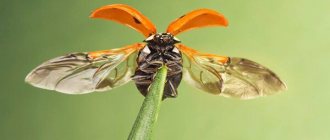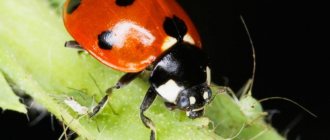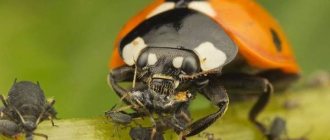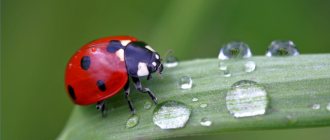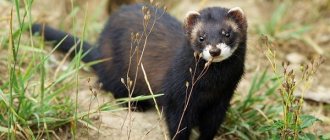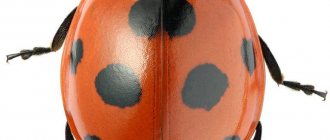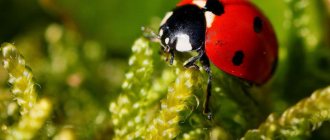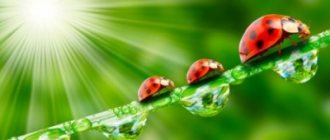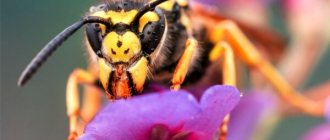The ladybug is a small, brightly colored bug that is familiar to everyone. The red back with black dots attracts the attention of adults and children when the insect crawls along a green leaf. In addition to its charming appearance, pleasing to the eye, the insect has a quality that benefits people - this predatory creature destroys insect pests in household plots and vegetable gardens.
So some summer residents breed ladybugs at home, then plant them in the garden to control pests without the use of chemicals, using environmentally friendly methods.
Origin of the species and description
Photo: Ladybug
The ladybug is a very common ancient arthropod insect all over the world, a representative of the order Coleoptera and the ladybird family. This insect received its scientific name Coccinellidae due to its scarlet color. The bug lives almost everywhere. It was popularly nicknamed the ladybug because of the poisonous white liquid or “milk” that the insect secretes to scare away predators, and the ladybug because it helped in the fight against aphids and other pests to preserve the harvest, had a gentle disposition, and did not cause any harm to humans. .
Video: Ladybug
In Germany and Switzerland, the tiny insect is called St. Mary's bug, in South America - St. Anthony's ladybug. There were many legends about this little bug; it was said to have the ability to influence the weather.
Interesting fact: Even in ancient times, the Slavs considered the ladybug to be a heavenly creature, a messenger of the sun. That is why she was often called “Sunny”. It was forbidden to drive away the insect, so as not to incur bad luck. A bright bug that flew into a home brought blessings.
There are a huge number of varieties of ladybugs: the entire family has more than four thousand species, which in turn are divided into 7 subfamilies and 360 genera. The ladybug differs from other representatives of the family Coccinellidae in the structure of its legs. In the structure of each of them there are three visible and one hidden segment, so they seem to be three-component.
Where did the name of the insect come from?
Before you figure out how many dots a ladybug has, it’s interesting to know why the insect was named that way.
It is believed that the colloquial name of the insect is explained by a respectful attitude towards it, and this name is different in different countries. In European countries, the insect is called the “Virgin Mary’s bug”, “sunshine”, in Latin America - “St. Anthony’s ladybug”. Most likely, the bug received the nickname “cow” due to its tendency to release “milk”—a liquid of a harmful composition—in case of a threat. Well, “God’s”, because the insect’s disposition is harmless and gentle. Its activity in nature comes down to the destruction of parasites and conservation of plantings.
Let's try to figure out how many dots a ladybug has and what it depends on.
Ladybug: description, structure, characteristics. What does a ladybug look like?
According to the biological classification, the ladybug is an arthropod insect that belongs to the Coleoptera and the family of ladybirds.
The size of a ladybug ranges from 4 to 10 mm. The shape of their body is either round or oval-elongated, flat below and very convex above. The body surface of some types of ladybugs is covered with fine hairs. The structure of their body includes a head, a pronotum, a chest consisting of three sections, an abdomen, wings with elytra and three pairs of paws.
The ladybug's head is small (although in some species it may be slightly elongated), it is motionlessly connected to the anterior chest. But the ladybug's eyes are relatively large. The insect's antennae, which consist of 8-11 segments, are highly flexible.
The ladybug's pronotum is convex, has a transverse structure and a notch at the anterior edge. On its surface there are often “signature” spots of different shapes.
Thanks to the presence of three pairs of paws, the ladybug can move quite quickly both on the grass and along plant stems. The abdomen of ladybugs consists of five or six segments, which are covered from below by sternites (segmental semirings).
Despite the fact that ladybugs have two pairs of wings, they fly only with the help of their two hind ones. The front wings, in the process of evolution, were transformed into hard elytra, which serve as protection for the hind wings at the moment when the ladybug is on the ground.
As a means of protection against predators, ladybugs are capable of secreting a kind of poisoned “milk” - cantharidin, a toxic yellow liquid that also has an unpleasant odor. Additionally, the bright colors of the ladybug scare away enemies. The color of the ladybug's protective covers can be not only bright red, but also yellow, black, white with spots of different colors and different configurations. Sometimes the pattern on the pronotum of a cow can indicate its gender.
What kind of lifestyle do they lead?
Regardless of the species, ladybugs lead a solitary life, showing a bright image of individualists . These insects are collected only for procreation. They also form flocks to fly to warm places (because they don’t like the cold).
But there are also sedentary individuals who huddle together during the winter in some secluded, abandoned place (under fallen bark, tree foliage, etc.). With the onset of warmth, they leave their shelter, scattering across meadows and clearings.
What does a ladybug eat?
Photo: Miraculous ladybug
The ladybug is a real predator among insects. Thanks to the structure of its jaw and the functioning of its digestive tract, it is able to hunt other insects and then quickly digest them. There are varieties that choose plant food: pollen, mold, flowers and leaves.
The diet of predatory species includes mainly:
- aphids in huge quantities;
- spider mites;
- caterpillars;
- insect larvae;
- butterfly eggs;
- some do not even disdain the larvae of Colorado beetles.
Ladybugs eat a lot, they are always hungry, especially their larvae. Each individual can easily destroy more than a hundred aphid larvae per day. Having large eyes, insects mainly use only their acute sense of smell in search of food.
The bugs do not hunt their victims, but only slowly, leisurely move through the foliage in search of food, and when they find a colony of aphids or a clutch of eggs of pests, they linger for a long time in this place for a meal until they destroy it completely. That is why the ladybug is a welcome guest on any personal plot, agricultural fields with crops, and in the garden. They are even specially bred at special enterprises and then distributed over cultivated lands with the help of agricultural aviation. Unfortunately, some varieties of these bugs, mainly living in Asia, cause damage to crops.
Now you know what ladybugs eat. Let's see how to breed these beautiful insects.
What does the bright warning color mean?
It is no coincidence that the ladybug is endowed with a bright color - it helps to survive in harsh natural conditions and scares away various enemies (predatory insects, birds, etc.). This is also a kind of mimicry, like a chameleon’s ability to adapt to the color of its environment (foliage, trees, sand, etc.) for the purpose of self-preservation.
And bright colors are warning signals for the wild world, indicating the inedibility and, possibly, toxicity of a potential victim. There is even a theory in the scientific world that goes something like this: “ The brighter the color of an insect, the less likely it is to be attacked by a predator .” Therefore, the red coloring looks something like a stop sign for all sorts of enemies. However, with age, the scarlet color fades.
Lifestyle
Ladybugs prefer to live “alone”, apart from other representatives of the species.
Only during the mating season do they come together to continue their family line. They also gather together for flights and wintering.
A ladybug can be called a fruit-loving bug, therefore, with the onset of a cold period, all insects living in temperate latitudes gather together and fly away to warm countries.
Among insects there is a sedentary species. They do not fly to countries with hot and dry climates, but gather in one place and winter in huge communities, reaching 400 million adult individuals. If you calculate how much such a “ball” weighs, you can get a figure equal to several tons.
To shelter from unfavorable climatic conditions, the “suns” hide in the ruins of stones and also take cover under fallen leaf blades of shrubs.
Under good conditions and the availability of food, spotted insects can live for 1 year. Under unfavorable conditions, the lifespan of insects does not exceed several months.
How and where do they winter?
Depending on the species, ladybugs overwinter in different ways. Sedentary species, adapted to existence in temperate climates, most often wait out the cold season, gathering in huge groups (up to several million individuals) and taking refuge under fallen leaves, under the bark of trees, between stones, hiding in buildings, such as barns, garages or even residential buildings. They fall into a state of torpor and emerge from cover only with the arrival of warmth.
Other species also unite in large colonies in the fall. But they do not stay for the winter, but fly south, where they spend the winter. Insects fly at high altitudes, descending to the ground during strong winds or rain. During such flights, many bugs die.
The colony
Interestingly, ladybugs always return exactly to the area from which they flew.
Types of ladybugs, photos and names
Zoologists identify 4,000 different species of ladybugs, divided into 7 subfamilies. We will describe the most interesting among them.
Two-spot ladybird
This is a beetle with a body length of up to 5 mm, with a dark red body and two black dots (hence the name).
Seven-spotted ladybird
It is this type of ladybug that is most common in Europe. Its size is 7-8 mm. Its elytra are painted red, there are three black spots on the sides, and the seventh is located near the head of the insect.
Twelve-spotted ladybug
This ladybug has a length of 6 mm, a bright pink or red color, and, accordingly, 12 black spots on the elytra.
Thirteen-spotted ladybird
This type of ladybug has as many as 13 spots against the background of red-brown elytra; some of its spots can merge with each other.
Asian ladybug
This ladybird is up to 7 mm long and is divided into two subspecies. One of them has a yellow wing cover with black spots, both large and small. The second subspecies is characterized by black coloration of the elytra, on which red-orange spots are visible.
Ocellated ladybird
This is a very large representative of the ladybird family, reaching up to 10 mm in length. It has red or yellow elytra and black spots surrounded by lighter rims.
Pointless ladybug
This is a very rare species; its characteristic feature is the absence of signature spots. Also, the red or brown body of the pointless ladybug is covered with small fibers.
Blue ladybug
This is another unusual member of the ladybug family, having a characteristic blue color. Such insects live exclusively in Australia.
Pine ladybug (four-spotted) (lat. Harmonia quadripunctata)
This species is the most common type of large ladybird found on coniferous trees, usually Scots pine. Color of elytra: brown, pink, salmon, yellow. Pattern color: black spots and cream stripes in two forms:
Pine ladybug (four-spotted) (lat. Harmonia quadripunctata)
- "16-spotted": 16 black spots in a 1-3-3-1 pattern on each elytra (most common) and
- "4-spotted": 4 black spots on the outer side of the elytra.
Number of points: 4-20 (usually 16). Pronotum: white with 5-9 black spots with a characteristic pattern. Leg color: brown. Other features: it often lies head down on pine buds, where it is very well camouflaged. Feeds on aphids.
Pine ladybug (four-spotted) (lat. Harmonia quadripunctata)
They overwinter in clusters in the bark of coniferous trees.
Social structure and reproduction
Photo: Ladybugs
All ladybugs are solitary. Only during the mating season do males use a specific smell to look for a female to mate with. This usually happens in early spring and soon the female lays up to 400 eggs on the lower surface of the leaves. They are oval in shape and can be yellow or orange. The female chooses a place for laying closer to the aphid colony so that the offspring are provided with food. This is the only manifestation of caring for their offspring. Most often, she dies after this.
After a couple of weeks, the larvae appear. Their body is covered with hairs and has a variegated color; the pattern combines yellow and brown spots. In the first days, the larvae eat the remaining egg shells and unfertilized eggs, then go in search of aphids. The stage lasts from 4 to 7 weeks, after which the formation of a pupa occurs, which then attaches to the edge of the leaflet, where its further transformation occurs.
At the end of it, after 8-10 days, the skin peels off from the pupa like a stocking to the end of the abdomen. A full-fledged individual ladybug appears, which gradually acquires its usual bright color. At first, its elytra are pale in color; by this feature one can easily distinguish an adult from a young one. Young bugs are ready to reproduce at 3 months of life, some only at six months - it all depends on the quality of nutrition and environmental conditions.
Lifestyle and habitat
Ladybugs live in almost every corner of the globe with the exception of Antarctica and the polar regions, where the air temperature never rises above zero. The habitat depends on the type of insect. It can be:
- any plants that have aphid colonies;
- meadows (most often located near water bodies);
- trees;
- field herbs;
- reed, sedge and other aquatic plants.
You can find bright bugs in a vegetable garden or garden, in a city park, on the edge of a forest.
Ladybugs are loners. They gather in groups only during the mating season, as well as for wintering or migrating to a warmer region. Insects are diurnal. They are in search of food, either crawling from plant to plant or making short flights.
Natural enemies of ladybugs
Photo: Ladybug in flight
The ladybug in the wild does not have many enemies due to the specific poisonous white secretion that it secretes. If a bird even once tastes a brightly colored bug, its bitter taste will discourage it from hunting for it for the rest of its life. Many insects quickly die from the ladybug's hemolymph.
The main enemy of ladybugs is dinocampus, a small winged insect that kills adult ladybugs and even its larvae by laying its eggs inside their bodies. As they develop, they feed on the body of their victim, and then the empty shell simply bursts, like in some famous horror films. Dinocampus finds bugs by their protective smell, with which they successfully scare away their other enemies. Parasites are capable of significantly reducing the number of ladybugs in a short period of time.
The active use of various chemicals for cultivating fields and the general depressing state of the environment also have a strong influence on the reduction in the population of these bright bugs. In some countries, there is a trend of replacing chemicals with natural, environmentally friendly methods of pest control. Ladybugs are bred in huge quantities and are even a national export item.
Where did the name of the insect come from?
Before you figure out how many dots a ladybug has, it’s interesting to know why the insect was named that way.
It is believed that the colloquial name of the insect is explained by a respectful attitude towards it, and this name is different in different countries. In European countries, the insect is called the “Virgin Mary’s bug”, “sunshine”, in Latin America - “St. Anthony’s ladybug”. Most likely, the bug received the nickname “cow” due to its tendency to release “milk”—a liquid of a harmful composition—in case of a threat. Well, “God’s”, because the insect’s disposition is harmless and gentle. Its activity in nature comes down to the destruction of parasites and conservation of plantings.
Let's try to figure out how many dots a ladybug has and what it depends on.
Population and species status
Photo: Ladybug
The population of ladybugs has decreased significantly due to active control of aphids. These little bugs simply have nothing to eat. Due to rapid reproduction and a small number of natural enemies, the population is able to recover in a short period of time if food is available. The status of the species is currently stable. At this time, only some rare varieties of these beetles are under threat of complete extinction, for example, the Australian blue and pointless ones.
Interesting fact: In search of food, a hungry ladybird larva can travel up to 12 meters, which is a huge distance for insects.
Trying to restore the population of beneficial bugs artificially, people sometimes, even with their good intentions, on the contrary, cause significant damage to it. In recent years, millions of individuals, specially bred ladybugs, have been released into their natural habitat, which, due to obvious mutations, changed the nature of their feeding and chose their own relatives as victims. All this caused the death of a huge number of beneficial bugs in all European countries. A thoughtful approach to this problem is needed without undue interference in the natural course of processes in nature.
Nutritional Features
Among the variety of ladybugs presented, almost all species act as predators. If we talk more specifically about what these beetles eat, then first of all we need to mention mites and aphids. Bright bugs also like to feast on:
- butterfly eggs;
- small caterpillars;
- insect pupae.
If there is not enough food, they even eat the eggs of the Colorado potato beetle. There are certain types who like exclusively plant-based foods. They can use:
- plant pollen;
- mushroom mycelium;
- fruits, flowers and leaves.
Ladybug protection
Photo: Ladybug from the Red Book
The ladybug has long been listed in the Red Book of many countries, including Russia. Its complete disappearance threatens to disrupt the balance in nature and actively multiply pests, which will then have to be destroyed with chemicals, and this in turn will further destroy the balance - a vicious circle is obtained.
Interesting fact: Until the forties of the 19th century, in many European countries and the United States of America, special workers tracked the wintering sites of ladybugs every fall and collected the insects in bags in winter, and then released them into gardens and fields in the spring. This environmentally friendly method of exterminating insect pests has been replaced by the active use of chemical means of killing aphids.
It is likely that in the near future people will completely abandon the use of chemicals and turn for help to ladybugs, which from time immemorial have lived next to people and helped them in the struggle for the harvest. It is not for nothing that since ancient times people have praised and worshiped this tiny bug.
Nowadays, the ladybug is successfully bred under artificial conditions. Then they are sent to the fields, but, according to many experts, it is enough just to create favorable conditions for these bugs and their population will recover on its own without human help and will remain at the level required by nature. It is necessary to maintain a balance, and for this, first of all, you should abandon the use of chemicals to treat crops against aphids, and also direct your efforts to reduce the overall level of environmental pollution.
The benefits and harms of ladybugs
The benefits of the ladybug, especially in our latitudes, are undeniable; the principle “the enemy of my enemy is my friend” works here. Ladybugs, by eating various insect pests, provide a great service to agricultural lands. Sometimes they are even specially bred in special places and then sprayed over fields and plantations infested with pests.
But among them there are also herbivorous species, most of them live in tropical areas, which can also harm agricultural crops.
What does a bug have from God, and what does it have from a cow?
There are many guesses about the name of this insect. But still, no one has canceled the divinity of this bug. This means that there is something supernatural in the purpose of the cow.
At the very least, this is a cute and, at first glance, innocent creature. And why the cow, actually? There is an opinion: precisely because this cow is also
produces milk, only it is secreted from the legs and serves to repel enemies, spiders and some insects
. Frogs are also not averse to eating ladybugs.
Interesting facts about ladybugs
- Since ancient times, people have revered ladybugs, which in the imagination of the ancients served as the personification of divine powers. For example, our ancestors, the ancient Slavs, considered ladybugs to be messengers of the Sun goddess.
- Also, since ancient times, people used ladybugs to predict the weather, so an insect flying away from the palm promised clear and sunny weather. And vice versa, a cow that wanted to stay on the hand was a harbinger of bad weather and rain.
- In many cultures, the ladybug is considered a symbol of good luck; for the same reason, many superstitions and signs are associated with them; the common belief is that in no case should you harm these insects, so as not to incur troubles and hardships.
- It is still a mystery to scientists how ladybugs always invariably return to the same places after their migrations for the winter.
Warnings
- Glass containers are not very suitable for keeping ladybugs. Glass retains heat, so insects can die from overheating.
- Ladybug bites can cause mild itching and irritation, so it is safer to catch and move them with a stick, brush or other tool to avoid discomfort.
- Always wash your hands after handling ladybugs. When frightened or threatened, these insects secrete an unpleasant-smelling liquid, and they have even been known to carry diseases.
